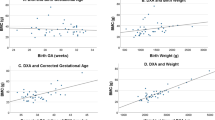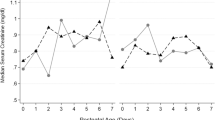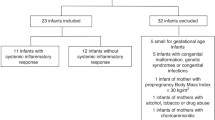Abstract
Factors affecting bone turnover in premature infants are not entirely clear but certainly are different from those influencing bones of adults and children.
To identify fetal and maternal factors that might influence bone turnover, we prospectively studied 50 infants (30 preterm and 20 full-term) born at Ain Shams University Obstetric Hospital in Cairo, Egypt. Maternal parity and medical history and infant's weight, gestational age, gender and anthropometrical measurements were recorded. Cord blood samples were collected and serum type I collagen C-terminal propeptide (PICP) was assessed as a marker for fetal bone formation. First morning urine samples were collected and pyridinoline cross-links of collagen (Pyd) were measured as an index for bone resorption. Serum PICP was higher in premature infants when compared with full-term infants (73.30 ± 15.1 versus 64.3 ± 14.7, p = 0.022) and was higher in male premature infants when compared with females (81.64 ± 9.06 versus 66.0 ± 15.7, p = 0.018). In a multiple regression model using PICP as the dependent variable and controlling for different infant and maternal conditions, PICP significantly correlated with infant gender (r = 8.26 ± 4.1, p = 0.05) maternal parity (r = −2.106 ± 0.99, p = 0.041) and diabetes (r = 22.488 ± 8.73, p = 0.041). Urine Pyd tended to increase in premature infants (612 ± 308 versus 434 ± 146, p = 0.057) and correlated significantly with gestational age (r = −63.93 ± 19.55, p = 0.002). Therefore, bone formation (PICP) is influenced by fetal age and gender, as well as maternal parity and diabetes. Bone resorption (Pyd) is mostly dependent on gestational age only. Further in-depth studies are needed to enrich management of this vulnerable population.
Similar content being viewed by others
Log in or create a free account to read this content
Gain free access to this article, as well as selected content from this journal and more on nature.com
or
Abbreviations
- PICP:
-
procollagen type-I carboxy-terminal propeptide
- Pyd:
-
pyridinoline
References
Ganong WF 2000 Hormonal control of calcium metabolism and physiology of bone. In: Ganong WF (ed) Review of Medical Physiology. Edn. Drawer L, California, pp 365–378
Bradbeer J 1992 Cell biology of bone remodeling. In: Edwards C, Lincoln D (eds) Recent Advances in Endocrinology and Metabolism. Churchill-Livingstone, Edinburgh, pp 95–115
Manolagas SC 2000 Birth and death of bone cells: basic regulatory mechanisms and implications for the pathogenesis and treatment of osteoporosis. Endocr Rev 21: 115–137
Namgung R, Tsang R 2000 Factors affecting newborn bone mineral content: in utero: effects on newborn bone mineralization. Proc Nutr Soc 59: 55–63
Tsukahara H, Watanabe Y, Hirano S, Tsubokura H, Kimura K, Mayumi M 1999 Assessment of bone turnover in term and preterm newborns at birth: measurement of urinary collagen crosslink excretion. Early Hum Dev 53: 185–191
Eriksen EF, Charles P, Melsen F, Mosekilde L, Risteli L, Risteli J 1993 Serum markers of type I collagen formation and degradation in metabolic bone disease : correlation with bone histomorphometry. J Bone Miner Res 8: 127–132
Crofton PM, Shrivastava A, Wade JC, Stephen R, Kelnar CJ, Lyon AJ, McIntosh N 1999 Bone and collagen markers in preterm infants: relationship with growth and bone mineral content over the first 10 weeks of life. Pediatr Res 46: 581–587
Risteli L, Risteli J 1993 Biochemical markers of bone metabolism. Ann Med 25: 385–393
Gfatter R, Braun F, Herkner K, Kohlross C, Hackl P 1997 Urinary excretion of pyridinium cross links and N-terminal cross linked peptide in preterm and term infants. Int J Clin Lab Res 27: 238–243
Marowska J, Kobylinska M, Lukaszkiewicz J, Talajko A, Rymkiewicz-Kluczynska B, Lorenc RS 1996 Pyridinium crosslinks of collagen as a marker of bone resorption rates in children and adolescents: normal values and clinical application. Bone 9: 669–677
Ballard JL, Khoury CJ, Wedig K, Wang L, Eilers-Walsman BL, Lipp R 1991 New Ballard score, expanded to include extremely premature infants. J Pediatr 119: 417–423
Usher RH, Mclean FH 1969 Intrauterine growth of live-born infants: Standards obtained from measurements of infants born between 25 and 44 weeks of gestation. J Pediatr 74: 901–910
Winterbottom N, Vernon S, Freeman K, Daniloff P, Garnero P, Seyedin S 1992 An immunoassay for the C-terminal propeptide of type I collagen. J Bone Min Res 7( Suppl 1): 254
Lieuw-A-Fa M, Sierra RI, Specker BL 1995 Carboxy-terminal propeptide of human type I collagen and pyridinium cross-links as markers of bone growth in infants 1 to 18 months of age. J Bone Miner Res 6: 849–853
SAS Institute Inc 1997 SAS/STAT Software: Changes and enhancements through release 6.12. Cary, NC 831–843
Risteli J, Risteli L 1999 Products of bone collagen metabolism. In: Seibel MJ, Robins SP, Bilezikian JP (eds) Dynamics of Bone and Cartilage Metabolism. Academic Press, San Diego, pp 275–287
Seibold-Weiger K, Wollmann HA, Ranke MB, Speer CP 2000 Plasma concentrations of the carboxyterminal propeptide of type I procollagen (PICP) in preterm neonates from birth to term. Pediatr Res 48: 104–108
Kajantie E, Dunkel L, Risteli J, Pohjavuori M, Andersson S 2001 Markers of type I and type III collagen turnover as indicators of growth velocity in very low birth weight infants. J Clin Endocrinol Metab 86: 4299–4306
Shiff Y, Eliakim A, Shainkin-Kestenbaum R, Arnon S, Lis M, Dolfin T 2001 Measurement of bone turnover markers in premature infants. J Pediatr Endocrinol Metab 14: 389–395
Fujimoto S, Kubo T, Tanaka H, Miura M, Seino Y 1995 Urinary pyridinoline and deoxypyridinoline in healthy children and in children with growth hormone deficiency. J Clin Endocrinol Metab 80: 1922–1928
Husain SM, Mughal Z, Williams G, Ward K, Smith CS, Dutton J, Fraser WD 1999 Urinary excretion of pyridinium crosslinks in healthy 4–10 year olds. Arch Dis Child 80: 370–373
Fraser WD 1998 The collagen crosslinks pyridinoline and deoxypyridinoline: a review of their biochemistry, measurement, and clinical application. J Clin Ligand Assay 21: 102–110
Zanze JC, Souberbielle C, Kindermans C, Rossignol C, Garabedian M 1997 Procollagen propeptide and pyridinium cross links as markers of type I collagen turnover: sex and age related changes in healthy children. J Clin Endocrinol Metab 82: 2971–2977
Harrast SD, Kalkwarf HJ 1998 Effects of gestational age, maternal diabetes, and intrauterine growth retardation on markers of fetal bone turnover in amniotic fluid. Calcif Tissue Int 62: 205–208
Author information
Authors and Affiliations
Corresponding author
Rights and permissions
About this article
Cite this article
Aly, H., Moustafa, M., Amer, H. et al. Gestational Age, Sex and Maternal Parity Correlate with Bone Turnover in Premature Infants. Pediatr Res 57, 708–711 (2005). https://doi.org/10.1203/01.PDR.0000160591.70409.C8
Received:
Accepted:
Issue date:
DOI: https://doi.org/10.1203/01.PDR.0000160591.70409.C8
This article is cited by
-
Relationship of caffeine regimen with osteopenia of prematurity in preterm neonates: a cohort retrospective study
BMC Pediatrics (2022)
-
Can serum periostin predict bronchopulmonary dysplasia in premature infants?
Pediatric Research (2022)
-
Could low birth weight and preterm birth be associated with significant burden of hip osteoarthritis? A systematic review
Arthritis Research & Therapy (2018)
-
Caffeine is a risk factor for osteopenia of prematurity in preterm infants: a cohort study
BMC Pediatrics (2018)



